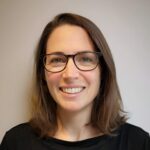Published
20 August 2025
Author
Alex Stewart is a specialist speech and language therapist working at Great Ormond Street Hospital. Alex shares her career journey from finding her place in the world of speech and language therapy, to embarking on research which led her to work in the highly specialised area of high-resolution manometry.
Speech and language therapy as a career is rewarding and challenging, joyous and heartbreaking, and so much more than people expect. It is privilege to be able to sit and reflect, as I write this, on what my career has given me so far, how I’ve ended up doing what I’m doing, and think about where my job might take me next.
My SLT journey has led me to specialise in children’s eating, drinking and swallowing difficulties and become a clinical-academic, something I never could have predicted when I first thought about speech and language therapy 30 years ago. So how have I ended up in a job that I find rewarding on so many levels?
Finding the right fit
To be honest, it didn’t start out too promisingly! A couple of years into my undergrad SLT course, after having done a couple of placements, I thought – I really can’t see myself doing this. But then an inspiring placement in a head and neck team made me realise just how varied the profession was and that maybe, I just needed to find the right bit of speech and language therapy.
“It was a steep learning curve, with exposure to a very wide variety of speech, language and communication difficulties”
My first job was a rotation post, working with children in mainstream and special needs schools and adults in a community outpatient clinic supporting those with voice disorders, dysfluency and acquired communication difficulties. It was a steep learning curve, with exposure to a very wide variety of speech, language and communication difficulties providing an excellent foundation, but none of these ‘bits’ felt right for me. However, I did know that I had a real desire to try working in a hospital.
A fantastic job was advertised at the Royal London Hospital working half the time with adults and half the time with children in an acute setting. The role provided on the job dysphagia training, giving me a unique opportunity to develop dysphagia assessment and management skills across the lifespan. While I liked working with adults, I found what I really enjoyed was working with children and this was where I found my place. Working so closely with other members of the multi-disciplinary team, problem-solving together and seeing what an impact our support could have for families was rewarding, and I found it genuinely interesting. When the opportunity came to specialise in paediatrics, I grabbed it. After a couple of years, I moved to Great Ormond Street Hospital and have been working there ever since.
Shaping a career
Over the years, I’ve had to fit my job around changes in my life. Commuting and working part time across multiple settings meant I couldn’t always work in my specialist area, but it did mean I learnt new skills in other settings, which helped me develop as an SLT.
What has really shaped my career though, has been the emergence of a clinical-academic training pathway. Although I’d always felt that speech and language therapy had value to children with eating, drinking and swallowing difficulties, there were and continue to be, so many unanswered questions. How can we be better at what we do? How do we know what works? These are the types of questions that now drive me day to day.
A move into research
I started investigating this further by enrolling in a funded Masters in Research, before embarking on a PhD a few years later. Both were funded by the NIHR (National Institute of Health Research) which meant my training fees were paid for while I still received my salary.
“I cannot put into words how much this research training has influenced me as an SLT”
I cannot put into words how much this research training has influenced me as an SLT. It has helped me ask questions, think critically, and seek to innovate to improve outcomes for children and their families.
One of these innovations is high resolution manometry with impedance (HRM-I) – an intimidating sounding, but valuable, tool used to define swallow physiology using a catheter inserted through the nose and into the oesophagus to measure swallow pressures. Semi-automated analysis using specially designed software provides a different perspective on the nature of a swallow impairment to that obtained from videofluoroscopy or FEES. If we understand the problem properly, we give ourselves a much better chance of finding a solution to that problem.
During my PhD, I used HRM-I to define swallow physiology in infants with oesophageal atresia, a rare congenital abnormality which can lead to life-long swallowing difficulties. It opened my eyes to how useful it could be in clinical practice, not just as a research tool. RCSLT have recently published a position paper and competency document to help other centres establish SLT-led HRM–I and I encourage you to take a look and think about how this innovation might support your own practice.
Supporting children, and their families is a huge part of why my job is so rewarding, but I’ve also found that thinking about how we can move our profession forward, how we can innovate and develop to improve outcomes through research is equally rewarding. It’s a part of our profession that I would encourage others to engage in to help us continually learn and develop, ultimately providing even greater rewards to us as individuals and to those we work with.
The RCSLT’s new position paper and competency framework on HRM are now available
 Alex Stewart
Alex Stewart


